Heilbrunn Timeline of Art History Essays
Nineteenth-century classical music.

"Antonius" Violin
Antonio Stradivari
- Dubois et Couturier
Niccolò Paganini (1782–1840)
Jean Auguste Dominique Ingres
Cornet à Pistons in B-flat
Courtois frères
Christian Frederick Martin
Grand Pianoforte
Érard , made in London
Square Piano
Robert Nunns
Grand Piano
- Steinway & Sons
The Music Lesson
John George Brown
Giosue Esposito
Julian Alden Weir
- Lyon & Healy
Two Young Girls at the Piano
Auguste Renoir
Jayson Kerr Dobney Department of Musical Instruments, The Metropolitan Museum of Art
October 2004
The nineteenth century brought great upheaval to Western societies. Democratic ideals and the Industrial Revolution swept through Europe and changed the daily lives of citizens at all levels. Struggles between the old world order and the new were the root causes of conflicts from the Napoleonic Wars to the American Civil War . From New York, to London, to Vienna, the world was changing and the consequences can still be felt to this day.
The lives of musicians, composers, and makers of musical instruments were greatly altered by these social changes. In earlier times, musicians were usually employed by either the church or the court and were merely servants to aristocratic circles. Composers wrote music for performances in these venues, and musical instrument makers produced instruments to be played by wealthy patrons or their servant musicians. With the rise of the middle class, more people wanted access to music performances and music education.
A new artistic aesthetic, Romanticism , replaced the ideals of order, symmetry, and form espoused by the classicists of the late eighteenth century. Romantics valued the natural world, idealized the life of the common man, rebelled against social conventions, and stressed the importance of the emotional in art. In music, Romanticism, along with new opportunities for earning a livelihood as a musician or composer, produced two seemingly opposite venues as the primary places for musical activity—the large theater and the parlor.
Music as Public Spectacle One result of the Industrial Revolution was the creation of a middle class. This new economic strata consisted of a larger number of people with more disposable income and more leisure time than had ever existed before. Musical extravaganzas that triumphed the musician or composer gained popularity with the masses of concertgoers. Beginning with Beethoven, composers began to arrange large concerts in order to introduce their works to the public. As audiences desired more, composers wrote larger musical works and demanded more of performers and their instruments.
The “bigger is better” mentality led to new musical forms such as the tone poem and large-scale symphonic and operatic works . Orchestras grew, including larger string sections with a full complement of woodwinds, brass, and ever more percussion instruments. New types of orchestral winds ( 2003.150a–g ) and brass ( 2002.190a–n ) that allowed for greater facility and more accurate playing were introduced. Composers such as Hector Berlioz, and later Johannes Brahms and Richard Wagner, continually pushed the limits of the available musical forms, performers, instruments, and performance spaces throughout the nineteenth century.
Musicians who could dazzle and amaze their audiences by their virtuosity became the first musical superstars. The two most famous nineteenth-century examples were the violinist Nicolò Paganini (1782–1840) and the pianist Franz Liszt (1811–1886). Both dazzled audiences throughout Europe with their performances, elevating the status of the musician from servant to demigod. Their fame grew throughout Europe, and their likenesses would be recorded in a variety of visual arts.
In order to withstand the virtuosic and often bombastic playing of these soloists, as well as to provide the type of volume needed in large concert venues, more powerful instruments were needed. Larger and louder violins like those by Antonio Stradivari (1644–1737) or Guarneri del Gesù (1698–1744)—preferred by Paganini—replaced the quieter and subtler violins of earlier masters like Jacob Stainer (ca. 1617–1683) or the Amati family. The demands of pianists like Franz Liszt pressed the technology and design of pianos to ever-larger instruments, eventually replacing the internal wooden structures of the eighteenth century with cast-iron frames that could withstand thousands of pounds of pressure.
Parlor Music Conversely, music gained popularity in the intimate nineteenth-century parlor. At the time, home life was centered in the salon, or parlor, where children played and learned with adult supervision, and where the family entertained company. Musical performances for small groups of people became popular events, and some composers/performers were able to support themselves financially by performing in these small venues and attracting wealthy patrons. Most famous among these was Frédéric Chopin (1810–1849).
Music in the parlor was of a very different sort than in the concert hall. Solo performances and chamber music were popular, and included everything from operatic and orchestral transcriptions to sentimental love songs and ballads. In the United States, hymns and folk songs by composers like Stephen Foster (1826–1864) supplemented the European repertoire.
With the rise of the parlor as the center of family life, music education became increasingly important. Children were often taught to play musical instruments as part of a well-rounded education; for girls, playing an instrument was more important than learning to read. When guests and potential suitors visited, the children and teenagers would entertain with performances of the latest popular works.
All sorts of musical instruments were used in the home, and at various times the guitar , harp ( 2001.171 ), concertina, and banjo were extremely popular. However, the most important musical instrument in the home was the piano, because it was useful as both a solo instrument and as accompaniment to a group of singers or instrumentalists. To accommodate home use, smaller pianos were created, first square pianos and later uprights. Small pianos took up less space and, although they were not as powerful as larger types, they were also less expensive. With the technological advances of the Industrial Revolution, the mass manufacturing of musical instruments—especially pianos—provided a seemingly endless supply for the huge markets of both the United States and Europe. The piano would remain a central component of domestic life until it was replaced by the phonograph, radio, and television in the twentieth century.
Dobney, Jayson Kerr. “Nineteenth-Century Classical Music.” In Heilbrunn Timeline of Art History . New York: The Metropolitan Museum of Art, 2000–. http://www.metmuseum.org/toah/hd/amcm/hd_amcm.htm (October 2004)
Further Reading
Samson, Jim, ed. The Cambridge History of Nineteenth-Century Music . Cambridge: Cambridge University Press, 2002.
Additional Essays by Jayson Kerr Dobney
- Dobney, Jayson Kerr. “ Archtop Guitars and Mandolins .” (September 2016)
- Dobney, Jayson Kerr. “ The Guitar .” (September 2007)
- Dobney, Jayson Kerr. “ The Piano: Viennese Instruments .” (March 2009)
- Dobney, Jayson Kerr. “ Military Music in American and European Traditions .” (October 2004)
Related Essays
- Military Music in American and European Traditions
- Music in the Renaissance
- The Piano: Viennese Instruments
- Alice Cordelia Morse (1863–1961)
- America Comes of Age: 1876–1900
- American Scenes of Everyday Life, 1840–1910
- Édouard Manet (1832–1883)
- Egyptian Revival
- George Inness (1825–1894)
- Henri de Toulouse-Lautrec (1864–1901)
- James McNeill Whistler (1834–1903)
- John Singer Sargent (1856–1925)
- Musical Instruments of the Indian Subcontinent
- Nineteenth-Century American Drawings
- Nineteenth-Century American Folk Art
- Nineteenth-Century American Jewelry
- Nineteenth-Century American Silver
- Photography and the Civil War, 1861–65
- Romanticism
- Violin Makers: Nicolò Amati (1596–1684) and Antonio Stradivari (1644–1737)
- Women Artists in Nineteenth-Century France
List of Rulers
- Presidents of the United States of America
- Central Europe and Low Countries, 1800–1900 A.D.
- France, 1800–1900 A.D.
- Great Britain and Ireland, 1800–1900 A.D.
- The United States and Canada, 1800–1900 A.D.
- 19th Century A.D.
- Biedermeier
- Brass Instrument
- Central Europe
- Musical Instrument
- North America
- Oil on Canvas
- String Instrument
- United States
- Wind Instrument
Artist or Maker
- Amati, Nicolò
- Böhm, Joseph
- Brown, John George
- Clark, John
- Courtois Frères
- Érard & Company
- Esposito, Giosue
- Graf, Conrad
- Ingres, Jean Auguste Dominique
- Martin, Christian Frederick
- Nunns, Robert
- Renoir, Auguste
- Stradivari, Antonio
- Weir, Julian Alden
Classical Music
By Allen C. Guelzo
Classical music stands apart from vernacular (or “folk” music) and from “popular” music (in the form of simplified commercial entertainment) in its complexity of structure and high level of performance requirements. Philadelphia established a major position in American classical composition and performance in the early nineteenth century, and maintained that position through its premier professional orchestra (the Philadelphia Orchestra, founded in 1900) and its elite music schools.
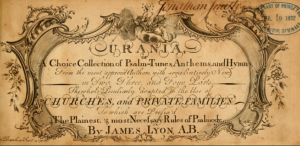
In planning a Quaker “holy experiment” on the Delaware River, William Penn (1644–1718) did not expect it to include music. But Quaker migrants were vastly outnumbered by German, Welsh, and other English settlers with no attachment to Quakerism and who had large community investments in musical performance, especially in the context of religious worship. Swedish Lutherans installed an organ in their first parish church, Gloria Dei , for use in services in 1700, and by the 1740s, Philadelphia’s German-speaking Moravians employed not only organs, but supporting instrumental bands of violins, oboes, flutes, and clarinets. The publication of religious music began in 1761, when James Lyon (1735–94) published the first native Philadelphia musical imprint, Urania, or A Choice Collection of Psalm-Tunes, Anthems, and Hymns . Andrew Adgate (1762–93) organized a short-lived Uranian Academy in Philadelphia in 1784 to promote church music.
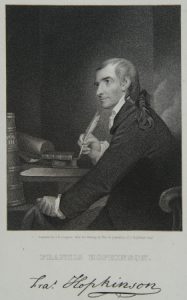
Secular classical music performance soon followed religious performance. Philadelphia’s first opera production, Alfred , by Thomas Arne (1710–78), was staged in 1757, and “subscription concerts” of secular music appeared in 1764. The first secular compositions published in Philadelphia came from the pens of lawyer and amateur musician Francis Hopkinson (1737–91) and Alexander Reinagle (1756–1809), who composed the earliest sonata-form music in Philadelphia for keyboard, his four “Philadelphia Sonatas,” in 1786. Raynor Taylor (1747–1825), who had been Reinagle’s teacher in London, followed his pupil to Philadelphia in 1792 and wrote the two most outstanding operas of the federal period, Pizarro, or The Spaniards in Peru (1800) and The Aethiop, or The Child of the Desert (1814). John Bray (1782–1822) composed The Indian Princess (based on the Pocahantas legend) in 1808, after moving to Philadelphia from the Royal Theatre in York, England, in 1805. Benjamin Carr (1768–1831), a prolific composer of sonatas, marches, and overtures, was the early republic’s most successful music publisher. They were joined by Charles Hommann (1803–72?), who made the first large-scale effort at American symphonic composition in the 1830s, writing a four-movement symphony in E flat, along with overtures, three string quartets, and a string quintet.
Development of Orchestras
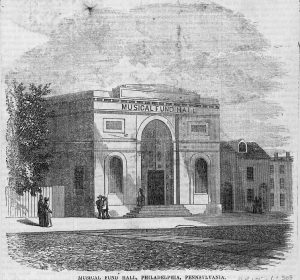
Orchestral concertizing in Philadelphia developed out of the small-scale ensembles of musicians hired to accompany plays and operas. None of them achieved much permanence until 1820, when Carr, Taylor, Hommann, and Hommann’s brother-in-law, Charles F. Hupfield (1822–95), founded the Musical Fund Society . The society offered its inaugural concert on April 24, 1821, at Washington Hall, on Third near Spruce Street, with a small orchestra of strings, flutes, and bassoons. In 1824, the society erected its own concert hall (on a design by William Strickland [1788–1854]) at Eighth and Locust Streets and gave its first concert there on December 29. A year later, the society organized a small music school to train new players. But by 1831, the music school had petered out, and although the society’s orchestra had risen in number to sixty-four players and programmed Philadelphia premieres of Beethoven symphonies, Haydn and Handel oratorios, and Weber and Mendelssohn overtures, it could not compete with the popular passion for imported Italian opera companies and celebrity performers from Europe— Ole Bull (1810–80) in 1845, Jenny Lind (1820–87) in 1850 and 1851, Henriette Sontag (1806–54) and child prodigy Adelina Patti (1843–1919) in 1852, Louis Antoine Jullien (1812–60) and his touring orchestra in 1853.
Operatic performance received further encouragement in Philadelphia from the construction of the new opera house at Broad and Locust, the Academy of Music , designed by Napoleon Le Brun (1821–1901) after the pattern of Milan’s La Scala. For two decades, until 1873, the Max Maretzek (1821–97) Italian Opera Company was the primary performer at the Academy of Music. It also played host to a variety of performance groups, including, from 1864 until 1891, the touring orchestra led by Theodore Thomas (1835–1905). But opera, beginning with Verdi’s Il Trovatore in 1857, dominated the stage, and in 1889, New York’s Metropolitan Opera began offering weekly performances, including Philadelphia’s first complete Ring des Niebelungen cycle.
One of the most successful of the touring orchestras was the Germania Musical Society, and in 1856, as the Musical Fund Society’s orchestra spluttered into oblivion, a local Germania Orchestra was organized in Philadelphia to showcase German classical music. The Germania mustered twenty-eight musicians, conducted by Carl Sentz (1828–88), Charles M. Schmitz (1824–1900), and William Stoll (1847–1910). The orchestra drew on Philadelphia’s large German immigrant community—the fourth-largest in the United States in the mid-nineteenth century—for both audiences and membership, and relied on a heavily Germanic repertoire, from Mendelssohn to Lizst, until it, too, folded in 1895. It was quickly succeeded by a new professional orchestra, known as the Thunder Orchestra from its conductor, Henry George Thunder (1865–1958), which performed at Musical Fund Hall, and by an amateur orchestra, the Symphony Society of Philadelphia, under William Wallace Gilchrist (1846–1916), who also directed choirs at Philadelphia’s Holy Trinity Church, St. Mark’s Church, and St. Clement’s Church.
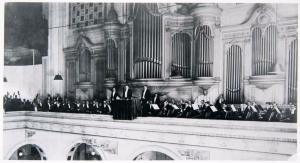
In 1899, an eighty-member Philadelphia Symphony Society was organized to perform benefit concerts for widows and orphans of U.S. soldiers in the Spanish-American War , and from these concerts, a permanent Philadelphia Orchestra was created in 1900, which gave its first concert at the Academy of Music under the direction of German-born Fritz Scheel (1852–1907) on November 16. After Scheel’s sudden death, he was succeeded by Karl Pohlig (1864–1928), and then in 1912 by the flamboyant Leopold Stokowski (1882–1977), who began a comprehensive campaign to restock the orchestra with first-line players and introduced a dizzying varieties of daring premieres—Gustav Mahler’s Symphony of a Thousand in 1916, Alexander Scriabin’s Poem of Ecstasy in 1919, Igor Stravinsky’s Le Sacre du Printemps in 1922, and Arnold Schoenberg’s Gurrelieder in 1932. Stokowski led the Philadelphia Orchestra in the first commercially sponsored orchestral radio broadcast in 1929. Stokowski also pioneered the orchestra’s first recordings , beginning in October 1917, with acoustic recordings of Brahms’ Hungarian Dances No. 5 and No. 6 for the Victor Talking Machine Company in neighboring Camden (released commercially in 1918).
The Philadelphia Orchestra’s place as one of the “Big Five” American orchestras (beside New York, Boston, Cleveland, and Chicago) was extended through the long directorship of Eugene Ormandy (1899–1985, director 1938–80), but began to falter under the controversial leadership of Ricardo Muti (b. 1940, director 1980–92) and Christoph Eschenbach (b. 1940, director 2003–8). Further criticism pursued the orchestra when it moved in 2001 from the Academy of Music to a new performance venue, the Kimmel Center for the Performing Arts , whose acoustics were considered inferior. In April 2011, the orchestra was forced to file for bankruptcy protection; it emerged from the proceedings in July 2012, only after reorganization of the orchestra’s endowment and pension fund and substantial concessions by claimants and the orchestra’s musicians.
Music Education
The principal partner of the orchestra in Philadelphia’s classical music world was the Curtis Institute of Music , founded in 1924 by Mary Louise Curtis Bok (1876–1970), a major supporter of the orchestra. Not only did the orchestra’s principal players teach at Curtis, but Curtis supplied a major portion of the orchestra’s recruits (Mason Jones [1919–2009], principal horn, 1938–78; John de Lancie [1921–2002], principal oboe, 1954–77; Anshel Brusilow [b. 1928], concertmaster, 1959–66). Curtis also trained a series of prominent instrumental soloists conductors and composers.
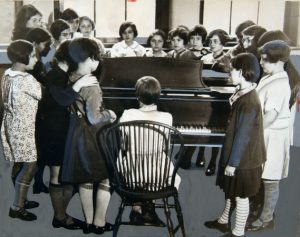
However, the Curtis Institute was not the first major music education enterprise in Philadelphia. It was preceded by the Zeckwer Academy, founded by Richard Zeckwer (1850–1922) in 1870 at Twelfth and Spruce Streets, which merged in 1917 with the Hahn Conservatory, founded by Frederick Hahn (1869–1942), to become the Zeckwer-Hahn Philadelphia Musical Academy, and then simply Philadelphia Musical Academy (PMA). Two of the most important names associated with PMA were the composers Marc Blitzstein (1905–64) and Leo Ornstein (1893–2002). The academy merged in 1962 with yet another music school, the Philadelphia Conservatory of Music (founded 1877, at 216 S. Twentieth Street). PMA eventually retitled itself as the Philadelphia College of Performing Arts in 1976 just before it merged with the Philadelphia Dance Academy. Finally, after another series of mergers, it was reinvented yet again in 1987 as a college within the University of the Arts , at Broad and Pine Streets. The Academy of Vocal Arts , at Nineteenth and Spruce, was founded in 1934 to offer training in opera (and operatic languages) and voice, and counts among its prominent alumni Joyce DiDonato (b. 1969) and Joy Clements (1932–2005).
The city’s universities also have also been home to music departments with substantial performance reputations, especially the Boyer College of Music and Dance at Temple University, created in 1962, and the music department of the University of Pennsylvania, founded in 1875 by Canadian-born Hugh Archibald Clarke (1839–1927), who also wrote several outstanding textbooks in musical theory: A System of Harmony (1901), Counterpoint Strict and Free (1901), and Harmony on the Inductive Method (1880). The New School of Music, founded by Max Aronoff (1906–81) in 1943 and housed from 1968 at Twenty-First and Spruce Streets, concentrated exclusively on training orchestral musicians and was absorbed in the creation of Temple’s Boyer College in 1985.
Younger musicians enjoyed participation in orchestral performance through the Youth Orchestra of Philadelphia (beginning in 1939) and the Settlement Music School , which was originally a project by Jeanette Selig Frank (1886–1965) and Blanche Wolf Kohn (1886–1983) in 1908 to provide music education to the school-aged children of immigrant communities in Southwark. Settlement operated multiple branches throughout the city for musically gifted children.
The Curtis Institute and the city’s universities and colleges have been home for a number of prominent twentieth-century Philadelphia-based composers. Curtis trained Gian Carlo Menotti (1911–2007), Lukas Foss (1922–2009), Jennifer Higdon (b. 1962), and especially Philadelphia’s own Vincent Persichetti (1915–87) and Samuel Barber (1910–81). Harl McDonald (1899–1955), the director of the University of Pennsylvania’s Music Department, composed four symphonies (1932–35) and a concerto for two pianos; his successor, George Rochberg (1918–2005), wrote six symphonies, Cheltenham Concerto (1958), and seven string quartets. Louis Gesensway (1906–76) wrote the only distinctively Philadelphia-themed symphonic work, The Four Squares of Philadelphia , for narrator and orchestra, in 1955.
Other Classical Organizations
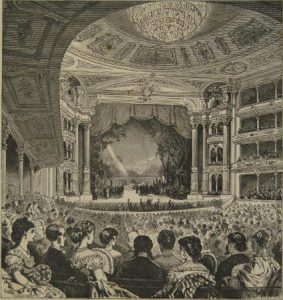
Opera in Philadelphia enjoyed more numerous but more short-lived incarnations. Three separate Philadelphia Grand Opera Companies attempted to attract audiences between 1916 and 1932. The New York operatic entrepreneur Oscar Hammerstein (1895–1960) built a Metropolitan Opera House on North Broad Street in 1908 to house an experiment he christened as the Philadelphia Opera Company, but the company survived for only two years. Sylvan Levin (1903–96) organized a second Philadelphia Opera Company in 1938, but it closed in 1944. Fourteen years later, the Philadelphia Lyric Opera Company launched yet another effort to establish a regular opera presence in Philadelphia with a production of Giacomo Puccini’s La Boheme —which also served as its last opera production in 1974, when the Lyric Opera merged with its rival, the Philadelphia Grand Opera Company, which had originally debuted in 1924 as the La Scala Grand Opera Company. The merger, originally known as the Opera Company of Philadelphia, renamed itself in 2013 as Opera Philadelphia.
The Philadelphia Chamber Music Society, founded in 1966 by Anthony Checchia (b. 1930), and the thirty-three-member Philadelphia Chamber Orchestra, founded by Marc Mostovoy (b. 1942) in 1964 as the Concerto Soloists of Philadelphia, offered full seasons of small-ensemble performances. In the late twentieth and into the twenty-first century, The Mendelssohn Club, Choral Arts Society, and the Singing City Choir, along with numerous city church choirs, provided musical performance outlets for both professional and amateur singers.
Radio broadcasts have been an important adjunct to classical performance in Philadelphia. An all-classical commercial radio station, WFLN (an acronym for the station’s parent owner, the Franklin Broadcasting Company), went on the air on March 14, 1949. Through live broadcasts, its large recorded library, talk-show interviews by host Ralph Collier (1922–2013), and its monthly magazine, the WFLN Philadelphia Guide, WFLN provided performance announcements, music advertising, and an on-air musical community. However, Philadelphia’s major public radio outlet, WHYY, abandoned its classical broadcasts in 1990, and WFLN experienced a series of sales of the station that resulted in its conversion from classical to heavy-metal rock in September 1997. This left classical music only part-time outlets through the Temple University public radio station, WRTI, and the University of Pennsylvania’s WXPN (which also subsequently dropped classical programming in favor of experimental pop fare). However, between 2012 and 2016, the Philadelphia Orchestra, WWFM/The Classical Network, and WRTI developed high-definition broadcast and streaming services, moving classical music in Philadelphia out of the world of analog broadcasting to digital.
The constituency for classical music in Philadelphia shrank in the twenty-first century, as in other places, as the costs of classical musical education and performance increased. The ease with which “pop” music dominated the performance and broadcast landscapes also made the complexity of classical music less attractive. Private funding for classical music by wealthy individuals, which was the norm in Philadelphia in the first half of the twentieth century, and from public sources—in school curriculums and municipal subsidies—diminished substantially. In an era of reduced public profile, classical composition and performance in Philadelphia became increasingly the preserve of academic environments.
Allen C. Guelzo is the Henry R. Luce Professor of the Civil War Era at Gettysburg College. (Author information current at time of publication.)
Copyright 2017, Rutgers University
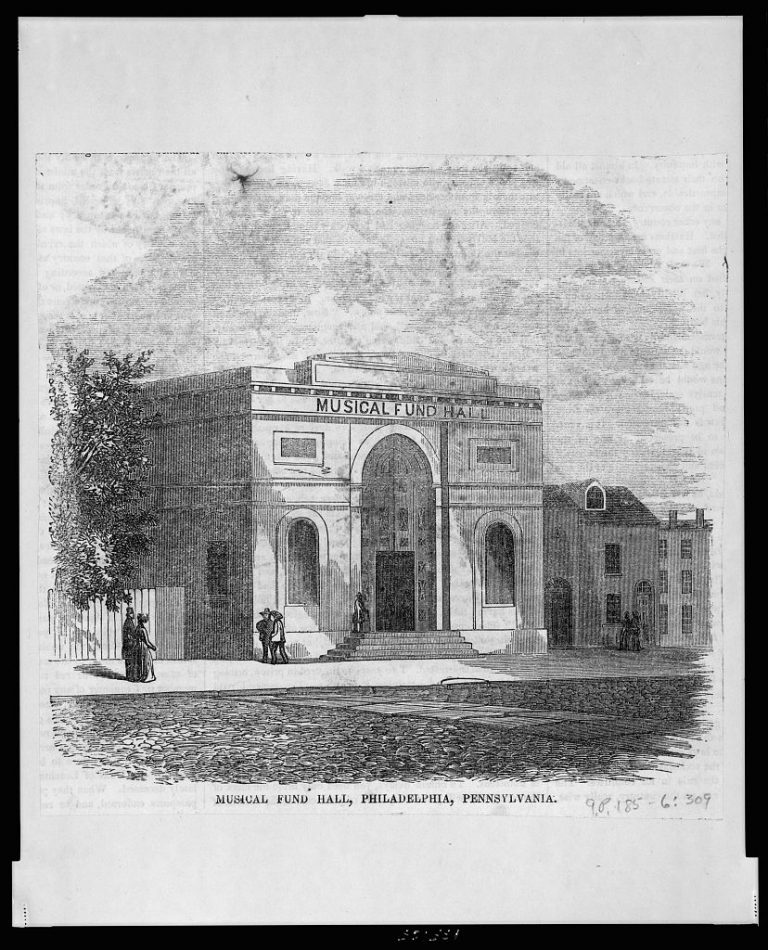
Musical Fund Hall
Library of Congress
A group of Philadelphia’s professional and amateur musicians formed the Musical Fund Society in 1820 and performed their first concert the next year. In 1824, they built their own performance space, Musical Fund Hall, at Eighth and Locust Streets. The venue hosted some of the most popular musicians of the nineteenth century, including Swedish opera singer Jenny Lind and violinist Ole Boll. After the 3,000-seat Academy of Music opened in 1857, Musical Fund Hall went into a long period of decline. It ceased use as a music venue in 1924, a hundred years after opened. In 1981, the building was converted to condominiums.
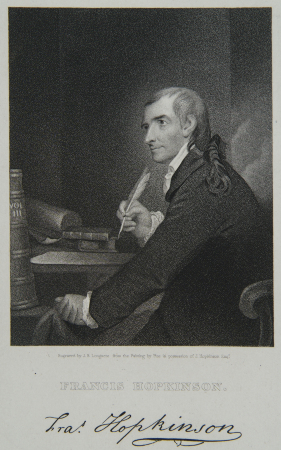
Francis Hopkinson
Historical Society of Pennsylvania
Francis Hopkinson’s 1759 composition for keyboard “My Days Have Been So Wondrous Free” was the first piece of music penned in the American colonies. Hopkinson was born in Philadelphia and was a member of the first graduating class of the College of Philadelphia, later the University of Pennsylvania. He wrote “My Days Have Been So Wondrous Free” shortly after his graduation. Hopkinson set his simple, light piece to lyrics by the Irish poet Thomas Parnell.
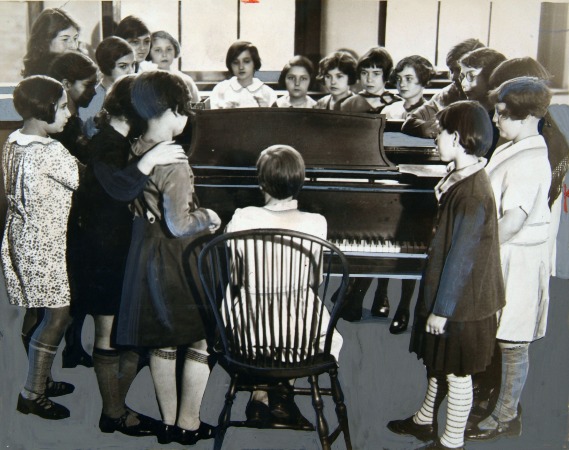
- Settlement Music School
Jeanette Selig Frank and Blanche Wolf founded the Settlement Music School in 1908 to teach the children of immigrants in Philadelphia’s Southwark neighborhood. Through a collaboration with the Curtis School of Music, they built their own schoolhouse in 1917 and began a pre-professional program for adults in 1924. The school employed teachers from the Philadelphia Orchestra since its earliest days. Notable alumni include rock-and-roll pioneer Chubby Checker, actor Kevin Bacon, future mayor of Philadelphia Frank Rizzo, and physicist Albert Einstein, who played violin in the school’s chamber ensembles in the 1950s. By the early decades of the twenty-first century, the school and its satellite schools had educated over three hundred thousand students.
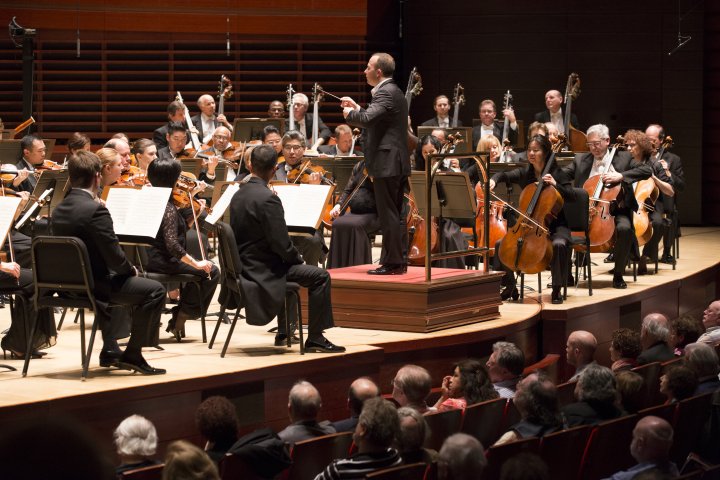
Philadelphia Orchestra at the Kimmel Center
Visit Philadelphia
The Philadelphia Orchestra was founded in 1900 and performed its first concert in November of that year. It became one of the “Big Five” orchestras, along with New York, Boston, Cleveland, and Chicago, and premiered a number of bold pieces, including Igor Stravinski’s controversial Le Sacre du Printemps . In 2001 the orchestra moved from its longtime home at the Academy of Music to the newly constructed Kimmel Center for the Performing Arts. Yannick Nézet-Séguin, shown in this photo, became music director of the orchestra in 2011. (Photograph by J. Griffin)
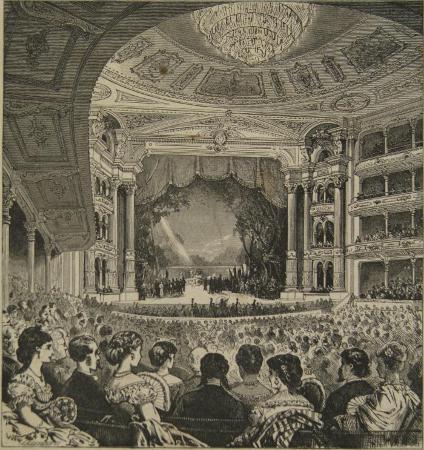
- The Academy of Music
The Academy of Music opened in 1857 with a performance of Verdi’s Il Trovatore. In the early twenty-first century, it was the oldest opera house in the United States that still was used for its original purpose.
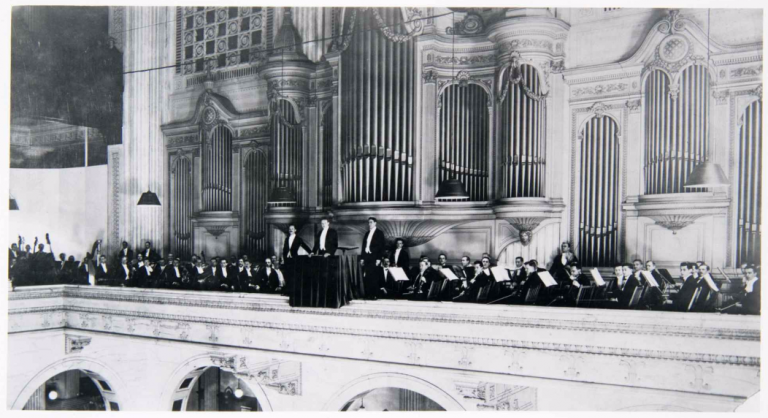
Philadelphia Orchestra at Wanamaker's Department Store
From 1912 through the 1940s, Polish-born Leopold Stokowski conducted the Philadelphia Orchestra. In this 1920s photo, Stokowski is shown leading the orchestra at Wanamaker’s Department Store.
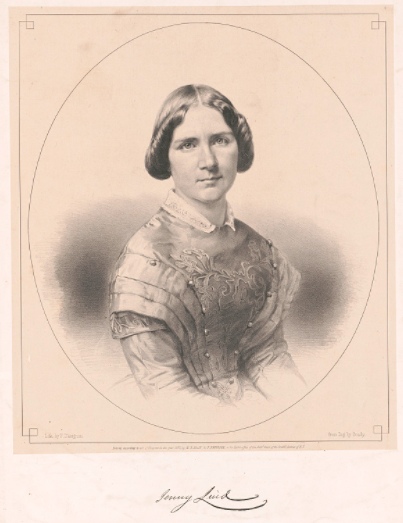
Jenny Lind, popularly known as “the Swedish Nightingale,” was one of many prestigious musicians to perform in Philadelphia’s Musical Fund Hall. From 1850 to 1852, Lind performed a series of ninety-three concerts in the United States at the invitation of P. T. Barnum.
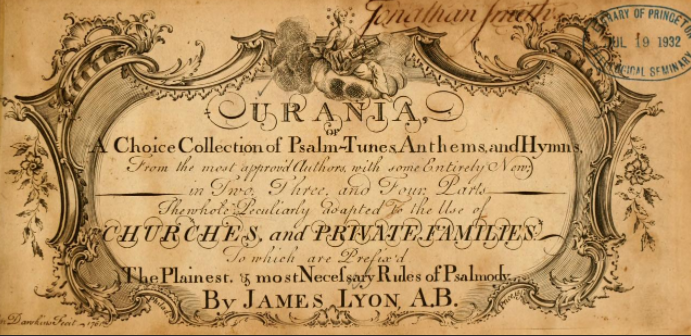
Urania, a Choice Collection of Psalm-Tunes, Anthems, and Hymns
Archive.org
James Lyon produced the first religious music native to Philadelphia in 1761. His 197-page work, titled Urania, a Choice Collection of Psalm-Tunes Anthems and Hymns , included both the sheet music and instructions for performing the pieces properly.

Related Topics
- Philadelphia and the World
- Philadelphia and the Nation
- Philadelphia, the Place that Loves You Back
- City of Firsts
- Athens of America
Time Periods
- Twenty-First Century
- Twentieth Century after 1945
- Twentieth Century to 1945
- Nineteenth Century after 1854
- Nineteenth Century to 1854
- Capital of the United States Era
- American Revolution Era
- Colonial Era
- Center City Philadelphia
- Avenue of the Arts
- Hail, Columbia
- Kimmel Center for the Performing Arts
- Musical Fund Society
- Musical Instrument Making
- My Days Have Been So Wondrous Free
- O Little Town of Bethlehem
- Opera and Opera Houses
- Philadelphia Orchestra
- Popular Music
Related Reading
Horowitz, Joseph. Classical Music in America: A History of Its Rise and Fall . New York: W. W. Norton, 2005.
Kupferberg, Herbert. Those Fabulous Philadelphians: The Life and Times of a Great Orchestra . New York: Charles Scribner’s Sons, 1969.
Madeira, Louis C. Annals of Music in Philadelphia and History of the Musical Fund Society, from Its Organization in 1820 to the Year 1858 . Philadelphia: J. B. Lippincott, 1896.
Marion, John Francis. Within These Walls: A History of the Academy of Music in Philadelphia . Philadelphia: Academy of Music Restoration Office, 1984.
Potter, Dorothy T. “Food for Apollo”: Cultivated Music in Antebellum Philadelphia . Bethlehem, Pa.: Lehigh University Press, 2011.
Shadle, Douglas W. Orchestrating the Nation: The Nineteenth-Century American Symphonic Enterprise . New York: Oxford University Press, 2015.
Related Collections
- Philadelphia Musical Association Papers Historical Society of Pennsylvania 1300 Locust Street, Philadelphia.
- Edwin A. Fleisher Collection of Orchestral Music Free Library of Philadelphia 1901 Vine Street, Philadelphia.
- Musical Fund Society Collection at the University of Pennsylvania Van Pelt Library 3420 Walnut Street, Philadelphia.
Related Places
- Curtis Institute of Music
- Musical Fund Hall (now residences)
Backgrounders
Connecting Headlines with History
- Despite financial difficulty, orchestra plays on (WHYY, April 18, 2011)
- Philly kids offer 'building blocks' for classical music, ballet (WHYY, October 5, 2011)
- New era begins for Philadelphia Orchestra (WHYY, January 25, 2012)
- Chubby Checker sings praises of Settlement school's music lessons for low-income kids (WHYY, March 7, 2012)
- Winners of Philadelphia classical music competition perform at the Kimmel (WHYY, October 28, 2016)
- With $2.5 M, seeking to discover Philly's next classical generation (WHYY, June 15, 2017)
- PhilaPlace: Musical Fund Hall (Historical Society of Pennsylvania)
- The Metropolitan Opera House Revisited (Hidden City Philadelphia)
- Philadelphia’s First Mega Musical Event (Hidden City Philadelphia)
- Before the Academy: Classical Music in the Quaker City (PhillyHistory Blog)
Connecting the Past with the Present, Building Community, Creating a Legacy
The Edvocate
- Lynch Educational Consulting
- Dr. Lynch’s Personal Website
- Write For Us
- The Tech Edvocate Product Guide
- The Edvocate Podcast
- Terms and Conditions
- Privacy Policy
- Assistive Technology
- Best PreK-12 Schools in America
- Child Development
- Classroom Management
- Early Childhood
- EdTech & Innovation
- Education Leadership
- First Year Teachers
- Gifted and Talented Education
- Special Education
- Parental Involvement
- Policy & Reform
- Best Colleges and Universities
- Best College and University Programs
- HBCU’s
- Higher Education EdTech
- Higher Education
- International Education
- The Awards Process
- Finalists and Winners of The 2022 Tech Edvocate Awards
- Finalists and Winners of The 2021 Tech Edvocate Awards
- Finalists and Winners of The 2020 Tech Edvocate Awards
- Finalists and Winners of The 2019 Tech Edvocate Awards
- Finalists and Winners of The 2018 Tech Edvocate Awards
- Finalists and Winners of The 2017 Tech Edvocate Awards
- Award Seals
- GPA Calculator for College
- GPA Calculator for High School
- Cumulative GPA Calculator
- Grade Calculator
- Weighted Grade Calculator
- Final Grade Calculator
- The Tech Edvocate
- AI Powered Personal Tutor
How to Set Up and Start Using a Cash App Account
Jazz research questions, interesting essay topics to write about japanese culture, good research topics about japanese art, jane eyre essay topics, most interesting invisible man essay topics to write about, most interesting jaguar essay topics to write about, most interesting jackson pollock essay topics to write about, good essay topics on italian renaissance, good research topics about islamophobia, fascinating classical music essay topics.

Fascinating Topics To Write About Classical Music
- Comparison of Baroque and Classical Music
- Baroque Music: The Forefather of Classical Music
- Are Popular and Classical Music Audiences the Same?
- Can Teaching Western Classical Music from Culturally Diverse Perspectives Benefit International Students?
- Classical Music and Cognitive Development Relationships
- The Impact of Classical Music on Society
- Has Classical Music Had An Influence on Rock Music?
- A Comparison of Classical Music and Jazz Music
- The Influence of Classical Music on Children
- The History of Classical Music and the Symphonic Era
- The Impact of Classical Music on Education
- Contrasting and Comparing Classical Music and Blues
- The Influence of Classical Music on Western Culture
- Does Classical Music Aid Your Studying?
- A Comparison of Rap and Classical Music
- Classical and Contemporary Music: A Comparison
- Introducing Variation Into Traditional Classical Music Forms
- Classical Music Has An Impact on Our Body’s Vital Movements
- Does Classical Music Influence Infant Brain Development?
- Theme and Variations In Classical Music
Research Topics About Classical Music
- A Comparison of Pop and Classical Music
- Does Classical Music Aid Plant Growth?
- How Franz Liszt’s Transcriptions Shaped Classical Music’s Path
- Ludwig Van Beethoven’s Impact on Classical Music
- Overview of Malaysian Classical Music and Malaysian Folk Music
- Classical Music’s Memory and Brain Effects
- North Indian Classical Music and Emotion: A Case Study
- Rock Vs. Classical Music: The Benefits and Drawbacks of Each
- Overview of Romanticism and Classical Music Styles
- Classical Music’s Impact On the World
- Parallels between Classical Music and Duke Ellington’s Jazz
- Cultural Studies In Eastern Classical Music
- The Classical Music Era’s Most Influential Composers
- “The Mozart Effect”: Can Classical Music Improve Academic Performance?
- The Benefits and Drawbacks of Classical Music
- Solving the War-Art Puzzle For Classical Music Composition Through War and Creativity
- Western Classical Music Evolution: A Statistical Examination of Composers’ Similarity, Distinction, and Evolution
- The Influence of Wolfgang Amadeus Mozart on Classical Music
- Bach’s Innovation In Comparison To Other Composers of the Era
- Discovering the Influence of Classical Music on Human Perception

20 Ways to Encourage Students to Respond ...
Cognitive psychology essay topics.
Matthew Lynch
Related articles more from author, interesting dynasties essay topics, good research topics about moral dilemma, antisemitism essay topics, good research topics about immigration reform, most interesting rolls-royce essay topics, research topics on domestic violence.
- Architecture and Design
- Asian and Pacific Studies
- Business and Economics
- Classical and Ancient Near Eastern Studies
- Computer Sciences
- Cultural Studies
- Engineering
- General Interest
- Geosciences
- Industrial Chemistry
- Islamic and Middle Eastern Studies
- Jewish Studies
- Library and Information Science, Book Studies
- Life Sciences
- Linguistics and Semiotics
- Literary Studies
- Materials Sciences
- Mathematics
- Social Sciences
- Sports and Recreation
- Theology and Religion
- Publish your article
- The role of authors
- Promoting your article
- Abstracting & indexing
- Publishing Ethics
- Why publish with De Gruyter
- How to publish with De Gruyter
- Our book series
- Our subject areas
- Your digital product at De Gruyter
- Contribute to our reference works
- Product information
- Tools & resources
- Product Information
- Promotional Materials
- Orders and Inquiries
- FAQ for Library Suppliers and Book Sellers
- Repository Policy
- Free access policy
- Open Access agreements
- Database portals
- For Authors
- Customer service
- People + Culture
- Journal Management
- How to join us
- Working at De Gruyter
- Mission & Vision
- De Gruyter Foundation
- De Gruyter Ebound
- Our Responsibility
- Partner publishers

Your purchase has been completed. Your documents are now available to view.
Why Classical Music Still Matters
- Lawrence Kramer
- X / Twitter
Please login or register with De Gruyter to order this product.
- Language: English
- Publisher: University of California Press
- Copyright year: 2007
- Main content: 251
- Published: May 2, 2007
- ISBN: 9780520933644

- Environment
- Information Science
- Social Issues
- Argumentative
- Cause and Effect
- Classification
- Compare and Contrast
- Descriptive
- Exemplification
- Informative
- Controversial
- Exploratory
- What Is an Essay
- Length of an Essay
- Generate Ideas
- Types of Essays
- Structuring an Essay
- Outline For Essay
- Essay Introduction
- Thesis Statement
- Body of an Essay
- Writing a Conclusion
- Essay Writing Tips
- Drafting an Essay
- Revision Process
- Fix a Broken Essay
- Format of an Essay
- Essay Examples
- Essay Checklist
- Essay Writing Service
- Pay for Research Paper
- Write My Research Paper
- Write My Essay
- Custom Essay Writing Service
- Admission Essay Writing Service
- Pay for Essay
- Academic Ghostwriting
- Write My Book Report
- Case Study Writing Service
- Dissertation Writing Service
- Coursework Writing Service
- Lab Report Writing Service
- Do My Assignment
- Buy College Papers
- Capstone Project Writing Service
- Buy Research Paper
- Custom Essays for Sale
Can’t find a perfect paper?
- Free Essay Samples
- Classical Music
Essays on Classical Music
In your classical music essay explore the music that has passed the test of time and nowadays has not lost its relevance. Classical music belongs to a specific period in the history of music, which authors of essays on classical music refer to as the classical period, or the period of classicism, that took place in the 18th and 19th century. Writers of essays name some of the world’s most famous classical musicians: Beethoven, Bach, Mozart, Brahms, Wagner, Tchaikovsky, Chopin, Vivaldi, and others – the list can go on. Classical music essays define depth, elegance, and harmony as the most common features of classical music. If you need some ideas, check out our classical music essay samples. We listed the best essay samples below for you to learn from.
One of the performances was titled “Romeo and Juliet” by Sergei Prokofiev, a ballet based on the play by William Shakespeare titled “Romeo and Juliet.” The performance of Sergei Prokofiev’s work ended differently from the William Shakespeare’s play, which had a sad ending. The performance exhibited Juliet returning to life...
The United States and Classical-Style Composers The United States is one of the nations that host great classical-style composers. For example, Hector Berlioz and Richard Wagner who compose music such as folks, blues, pop and jazz styles for performance. According to Rosen (2005), the industrial revolution and the struggle for democracy...
Music and its Structures Music is a sequential type of art that has been annotated for a long time by vibrational methods. Classical tunes are created using a variety of structures in music. The theme character is made up of tiny groups of stages that complete the musical premise. It is...
Claude Debussy, a prominent French composer who was one of the most protuberant figure that was involved in the late 19th and 20th century impressionist music and Gustav Mahler who was an Austrian romantic composer and served as a link amid the modernism of the earlier 19th and 20th century...
Found a perfect essay sample but want a unique one?
Request writing help from expert writer in you feed!
Ludwig van Beethoven’s Symphony No. 5 in C Minor, Op. 67 ”Allegro con brio” (first movement), first carried out in 1808, has always been an eye-opener to me because of how it is delivered by revealing to the ears and the deepest part of my soul. This is with regards...
Ludwig Van Beethoven: A Musical Genius Ludwig Van Beethoven was a pianist and composer of German origin. His music is greatly distinct from the rest because of their large extended architectonic designs that featured broad templates, musical materials, and motifs developed through 'modulation' technique (Swafford 92). The Technique of Modulation The technique involved...
10-day Orchestra Nights at Barbican On September 14th at 7:30pm, 10-day orchestra nights was organized by Barbican. It featured local and international Classical music. This program brought the best orchestras and international artists to London. Staged orchestras, operas and contemporary compositions were some of the wonders of music seen in this...
Words: 1082
Related topic to Classical Music
You might also like.
Classical music essay
The world has gotten too complicated. People have too many choices in their hands that sometimes they end up with the wrong priorities. This points out why there are many things today in the world that can use some changes to make lives more meaningful and worthwhile. In this regard, one thing that I would definitely change is the way people regard classical music and to make them appreciate more and benefit from the real wonders of music. More specifically, I want people in America to shift their disdain to classical music into a newfound love, so that they can enjoy the benefits it can bring to their lives.
People consider any sound that is refined, stylish and mostly instrumental as classical music. It is seen more as something appreciated only by the elite or the educated. This should not be the case. Classical music, as the term connotes, is part of the classics. It consists of creations of the eighteenth and nineteenth century composers, like Johann Sebastian Bach and Ludwig van Beethoven. This type of music is usually characterized by a beautiful melody and performed by an orchestra (“The Music of Bach”). Classical music, through the years, has taken on various permutations.
It can also be appreciated in the variations of the art songs, opera and oratorio. The art song consists of a poem performed by a trained singer with a classical music background. The creations of the poet, singer, composer and musician conspire for an art song masterpiece (“Lotte Lehmann Foundation”). The oratorio, on the other hand, is a musical creation that has a more philosophical or religious lyrics and context. It is performed by an orchestra with the soloists delivering the story line. Opera on the other hand is the art of singing a drama accompanied with the music of an orchestra.
Today, people are engrossed too much on the boisterous music of pop and rock that these classic art forms are often left to the enjoyment of a select few. The classical genres are far from being exclusive. The classical music just so happens to be not utilized and enjoyed by majority of the public. Evidently, people do not know that they are missing a lot. Why is there a need to change the perception of people with regard to classical music? Basically, American adults should put an end to their ignorance and disregard to the classical music.
Related essays:
- What can the NPO change in its radio content to increase its reach of the Turkish and Moroccan-Dutch? essay
- General Observation essay
- Hegel’s Lectures on the Aesthetics essay
- Overview of the Project essay
Majority of the people are missing a lot by not opening their minds and considering their options with regard to this artistic creation. For one, classical music is deemed to have a therapeutic affect to its listeners. Studies show that the sound waves produced by classical music are capable of bringing harmony to the psyche of a person, thus bringing more balance to the existence of a person (Heather). Classical music can also provide good exercise to the entire brain, thus making one more intellectually perceptive and mentally capable.
Findings of a study illustrate that an active listener of the classics tend to utilize their brain more compared to the listeners of pop (Heather). For example, there are many people who suggest to a pregnant woman to listen to classical music, particularly to Mozart. This is due to the proposed Mozart effect that aids in optimizing the potentials and brain of a child, even at the stage of infancy or before birth (Jones). There are studies also that establish how music can enhance the learning and people skills of a person.
It does not necessarily make one smarter right away, but it provides the proper disposition to make a person perform better. The relaxing and energizing effect of the harmony and melody of a classical music can very well tap any potential inherent in a person (Lehman). Classical music is really worth loving. The likes of opera, oratorio and art songs are more than just performances. They are wonderful creations of talented people that relate a story that invokes feelings and touches the psyche. In the end, it is more than just being ‘cultured’ as what most people perceive it to be.
The effects are beyond what have been addressed to the senses. The social, intellectual and psychological growth it brings to the person showcase inspiring musical prowess that are definitely to aim for.
Works cited
Heather, Simon. “The Healing Power of Sound. ” Positive Health. 2002. Positive Health Publications. 2 July 2006. < http://www. positivehealth. com/permit/Articles/Sound_and_Music/heather64. htm > Jones, Martin. “The Mozart Effect. ” Human Intelligence. 2003. Indiana University. 2 July 2006. < http://www. indiana. edu/~intell/mozarteffect2. shtml#music >

Classical Music for Holy Week & Easter
Though Handel’s “Messiah” rightly reigns supreme as the king of music for Easter, there are many other seasonal masterpieces that deserve to be heard more often. Here are ten lesser-known classical works that brilliantly depict the dramatic events of Holy Week and Easter Sunday.

1. “Resurrexit” from the Messe Solennelle , by Hector Berlioz (1824)
The only part of a mighty Mass that the twenty-year-old (!) composer thought worthy of preserving (the rest of the Mass was reconstructed from orchestral parts discovered in a Belgian attic in the early 1990s), Berlioz’s “Resurrexit” is surely the most stirring realization of Jesus’ resurrection in all of music. It also makes one realize again how revolutionary was Berlioz’s music; the Mass was written three years before Beethoven’s death and yet already sounds like a work of post-Beethovenian Romanticism—though its being Berlioz’s music, it resembles no other composer’s work.
2. Stabat Mater , by Antonio Vivaldi (1712)
There have been many beautiful settings depicting the scene of the Mother of God standing in sorrow at the foot of the cross, but none more beautiful than this by “the Red Priest.” Yet more proof that this composer’s famous concertos are in fact the lesser of his creations.
3. Stabat Mater , by Gioachino Rossini (1841)
Rossini’s setting of the scene of the Stabat Mater —whose text comes from a 13th-century hymn possibly written by Pope Innocent III—comes a century and a quarter after the realization by his compatriot Vivaldi, and it is worlds apart in style as well as time. Drawing on the tradition of bel canto (“beautiful singing”) that he helped to make famous, Rossini’s effort is operatic in many sections, never more so than in the second movement, “Cuius animam gementem” (“Through her weeping soul”), in which the tenor sings, to a breezy tune, words of the utmost pathos.
4. The Mystery (Rosary) Sonatas , by Heinrich Ignaz Franz Biber (1676)
A series of fifteen short sonatas for violin and continuo based on the mysteries of the Rosary, this work composed by the seventeenth-century Austrian composer Franz Biber was unknown until 1905.
5. The Seven Last Words of Our Savior on the Cross , by Franz Joseph Haydn (1787)
Arranged variously for string quartet, orchestra, and orchestra and voices, Haydn’s Seven Last Words are a series of meditations on the seven final statements uttered by Jesus on the Cross.
6. Easter Oratorio , by Johann Sebastian Bach (1725)
Though not as well-known as the St. Matthew Passion and St. John Passion , Bach’s Easter Oratorio is a masterpiece in its own right.
7. Christ on the Mount of Olives , by Ludwig van Beethoven (1803)
The master’s sole oratorio dates from the same year as the composer’s epic “Eroica” symphony.
8. The Resurrection , by George Friedric Handel (1708)
Overshadowed at Easter by his Messiah , Handel’s oratario deserves to be better-known, as the rousing aria “Disserratevi porte d’averno” proves.
9. The King of the Jews , by Alexander Glazunov (1914)
The Russian composer created this music for a 1908 Mystery Play, employing orchestra and chorus, and drawing on the tradition of Russian Orthodox church music.
10. Lament of the Mother of God , by John Tavener (1988)
The composer himself wrote: “In the Orthodox Church, the Lament of the Mother of God is normally sung on Holy and Great Friday. In its full length it lasts about half and hour, and it is intoned by the Priest or Bishop while the people venerate the Epitaphios (or Shroud of the Dead Christ), which is in the centre of the church and decorated with flowers. The Lament must be sung with an ikon-like stillness and great purity. It grows in intensity as it climbs in tessitura, but without anything sudden or remotely melodramatic. For the Orthodox Church there is never the sense of absolute desolation felt by the Western Church on Good Friday. Hence the cry of the Mother of God ‘Dost thou change my grief to gladness by thy Resurrection?’, followed by the full forces: ‘Rise O God, and judge the earth.'”
This essay was first published here in April 2015.
The Imaginative Conservative applies the principle of appreciation to the discussion of culture and politics—we approach dialogue with magnanimity rather than with mere civility. Will you help us remain a refreshing oasis in the increasingly contentious arena of modern discourse? Please consider donating now .
The featured image is “The Angel of the Lord Announcing the Resurrection” (circa 1805) by Benjamin West and is in the public domain, courtesy of Wikimedia Commons .
All comments are moderated and must be civil, concise, and constructive to the conversation. Comments that are critical of an essay may be approved, but comments containing ad hominem criticism of the author will not be published. Also, comments containing web links or block quotations are unlikely to be approved. Keep in mind that essays represent the opinions of the authors and do not necessarily reflect the views of The Imaginative Conservative or its editor or publisher.

Share This Story, Choose Your Platform!
About the author: stephen m. klugewicz.

Related Posts
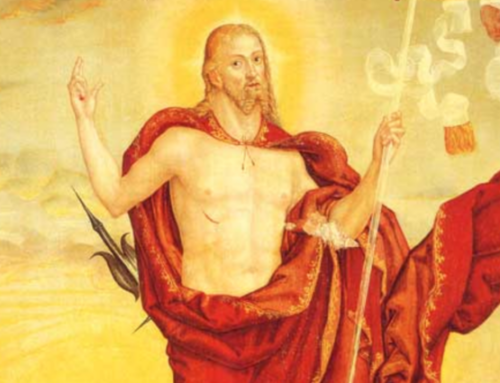
Legalizing the Resurrection

Easter Wings
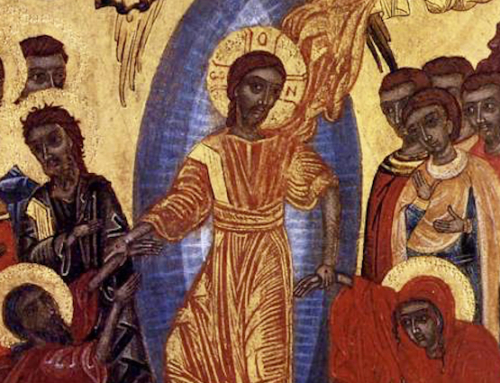
“Hail, Festive Day”: A Hymn to Easter

A Sonnet for Easter Dawn
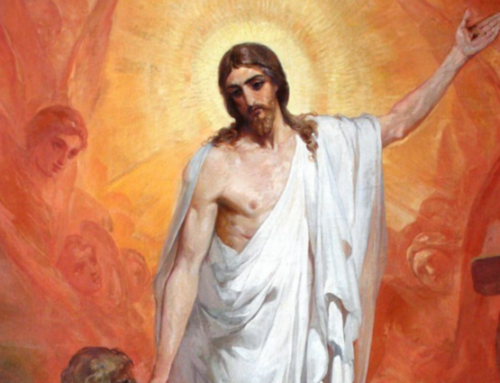
The Harrowing of Hell
25 comments.
Great Selection, Steve!
I think these are brilliant pieces, but I wonder at the lack of any Medieval or Renaissance choral pieces (even Mass settings) among them. I mean, I suppose Bieber counts, but Palestrina? Byrd? https://www.youtube.com/watch?v=_Zd8k8AYbVk
Thanks you, Steve. Truly moving and beautiful.
Good for you on these wonderful selections.
I would add as indispensable Francis Poulenc’s Stabat Mater, Arvo Part’s Stabat Mater, Antonin Dvořák’s Stabat Mater, Seven Last Words, by James MacMillan, Anton Bruckner’s Mass in F Minor – for the Et ressurexit and the Et expecto — Frank Martin’s oratorio, Golgotha, and Gustav Holst’s ineffably moving part song, “This have I done for my true love.”
I, a simple man, appreciate the suggestions. B y the way imaginative is my must read site every day.
Wow – thank you. I consider myself at least a passable classical music / sacred music fan but I have missed a few of these. How embarrassing! I will be sure to check them out.
I would add Heinrich Schütz’s “Historia der Auferstehung Jesu Christi.”
Wagner’s “Parsifal”
Easter hymn from Cavelleria rusticana: Zifferelli film version!
https://www.youtube.com/watch?v=0FLbTIzHD9A (Regina coeli for first minute: Solist sings from 2:25
Inneggiamo, il Signor non è morto. Ei fulgente ha dischiuso l’avel. Inneggiamo al Signore risorto— oggi asceso alla gloria del Ciel!
Let us sing hymns, the Lord is not dead. Shining, He has unsealed the tomb, Let us sing hymns to the risen Lord— ascended today to the glory of Heaven
Another beautiful choral piece is The Seven Last Words of Christ by Theodore DuBois: https://m.youtube.com/watch?v=6IyktBFoFBA
Two more: Ivan Moody’s Passion and Resurrection, and Sofia Gubaidulina’s St. John Passion.
Thank you for this list.
If I may, can I make the recommendation that Pavel Chesnokov’s “The Angel Cried” be added to the list. https://youtu.be/vkyP2Xim_5A
I would also recommend Szymanowski’s beautiful setting of the Stabat Mater.
Superb and touching as well. Thank you.
I really love #3, if only they could convince the people to dress properly!
Holst’s “Hymn of Jesus”, English text taken from the apocryphal Gnostic Gospel of St. John.
Steven, darling…no Mozart’s Requiem?
I also second “Parsifal”
and would add Pergolesi’s ‘Stabat Mater’
Arvo Pärt’s “Passio.”
I’ve made a playlist of these over on Spotify if anyone is interested. It’s called “Holy Week Classical” and it is in this order.
GOLGOTHA, the Passion oratorio by the 20th-century Swiss composer Frank Martin. An absolute masterpiece, one of the greatest Passions ever written.
Don’t forget Poulenc’s deeply affecting Stabat Mater.
Pergolesi Stabat Mater should be included: https://www.youtube.com/watch?v=qzOmPUu-F_M
I like The Crucifixion, by John Stainer/ Rimsky’s Russian Easter Overture/ Gorecki’s Symphony of Sorrowful Songs/ And of course Symphony #2 by Gustav Mahler
Very nice site, found some gorgeous music choices for holy week that I downloaded from you tube. Many thanks.
Leave A Comment Cancel reply
Save my name, email, and website in this browser for the next time I comment.
Home — Essay Samples — Entertainment — Concert Review — My Visit of the Classical Music Concert
My Visit of The Classical Music Concert
- Categories: Classical Music Concert Review
About this sample

Words: 1441 |
Published: Mar 18, 2021
Words: 1441 | Pages: 3 | 8 min read
Table of contents
Tchaikovsky romeo & juliet, fantasy-overture (1870) composed by: joseph giunta, works cited, tchaikovsky serenade for strings in c major, op. 48 (1881) composed by: joseph giunta, tchaikovsky violin concerto in d major, op. 35 (1881) composed by: joseph giunta, tchaikovsky polonaise & waltz from eugene onégin, op. 24 (1879) composed by: joseph giunta.
- Giunta, J. (Composer). (1870). Tchaikovsky Romeo & Juliet, Fantasy-Overture. [Audio recording].
- Giunta, J. (Composer). (1881). Tchaikovsky Serenade for Strings in C Major, Op. 48. [Audio recording].
- Giunta, J. (Composer). (1881). Tchaikovsky Violin Concerto in D Major, Op. 35. [Audio recording].
- Giunta, J. (Composer). (1879). Tchaikovsky Polonaise & Waltz from Eugene Onégin, Op. 24. [Audio recording].

Cite this Essay
Let us write you an essay from scratch
- 450+ experts on 30 subjects ready to help
- Custom essay delivered in as few as 3 hours
Get high-quality help

Verified writer
- Expert in: Entertainment

+ 120 experts online
By clicking “Check Writers’ Offers”, you agree to our terms of service and privacy policy . We’ll occasionally send you promo and account related email
No need to pay just yet!
Related Essays
4 pages / 1930 words
2.5 pages / 1220 words
2 pages / 1006 words
2.5 pages / 1035 words
Remember! This is just a sample.
You can get your custom paper by one of our expert writers.
121 writers online
Still can’t find what you need?
Browse our vast selection of original essay samples, each expertly formatted and styled
Related Essays on Concert Review
Live music has been an integral part of human culture for centuries, serving as a vehicle for artistic expression, entertainment, and social interaction. Concerts provide a unique opportunity for individuals to connect with [...]
Music has the power to bring people together and transcend barriers. Attending a concert is not only a chance to enjoy live music but also to immerse oneself in a unique cultural experience. As a college student, I had the [...]
In the last couple of months, I attended two concerts for my music report. The first concert was Maximus Musicus Visits the Orchestra which was held on 3 June 2018 at the Malaysian Philharmonic Orchestra(MPO). The second concert [...]
I decided to go to the “Dimensions in Jazz” concert which was directed by Wade Judy, Dr. Eric Bush, and Marko Marcinko. Before the performance started, there was a wide range of people entering. Some were students and some were [...]
After watching “I Lived” I felt as if I could do more to live my life to the fullest. The boy in the video is unfortunately affected by Cystic Fibrosis, yet he lives as if he does not have it. He does not let it get in the way [...]
Attending a jazz concert for the first time was a great experience; it was performed at Mt. Sac’s Feddersen Recital Hall on October 19, 2019. The musicians who took part in it were Bob Sheppard who alternated between the alto [...]
Related Topics
By clicking “Send”, you agree to our Terms of service and Privacy statement . We will occasionally send you account related emails.
Where do you want us to send this sample?
By clicking “Continue”, you agree to our terms of service and privacy policy.
Be careful. This essay is not unique
This essay was donated by a student and is likely to have been used and submitted before
Download this Sample
Free samples may contain mistakes and not unique parts
Sorry, we could not paraphrase this essay. Our professional writers can rewrite it and get you a unique paper.
Please check your inbox.
We can write you a custom essay that will follow your exact instructions and meet the deadlines. Let's fix your grades together!
Get Your Personalized Essay in 3 Hours or Less!
We use cookies to personalyze your web-site experience. By continuing we’ll assume you board with our cookie policy .
- Instructions Followed To The Letter
- Deadlines Met At Every Stage
- Unique And Plagiarism Free
Classical Music Concert “Toyota Symphonies for Youths” Essay
This is a response paper to a classical music concert I attended at the Disney Concert Hall in downtown Los Angeles on the 7 th of December 2012. The title of the concert was ‘ Toyota Symphonies for Youths ’ created by Adam Reilly and Igor Stravinsky of the Musical Dramaturg and Production Consultant.
The music was conducted by Dietrich Paredes and directed by Abigail Deser. The main idea was to showcase a mix of classical music for the youth. The music was blended with fun and fantasy to entertain teenagers and young people, who are known to enjoy fun music. The first piece of art that I saw was written by Leon Martell and choreographed by Kitty McNamee.
In the main auditorium there was a nice synchronized melody of the blend of different musical instrument and a beautiful vocal performance from the performers. There were four performers; one lady and three gentlemen. The lady was mainly doing the vocals while one of the gentlemen was playing the piano, the other was playing an oboe and the last one was playing a bassoon. As usual the stage was well lit and the performers had confidence as they entertained the audience.
Since this was a classical music concert, it was obvious the kind of audience that would appreciate the performance. One interesting thing about this concert is the fact that classical music was incorporated with vocals. This is one of the modernizations that this genre of music has had to undergo. Before, it was very uncharacteristic for classical music to use vocals. The writings of the music had to be written down in musical notes and instruments used as the only means of output.
Apart from the performance of the first group there were other groups that also performed the Hollywood Bowl Orchestra. The Hollywood Bowl Orchestra is an early piece that was first performed in 1922, by the Eugene Goossens. Just like in the previous performance the orchestra bands also did an amazing performance reading the notations from a script and playing the music with their different instruments.
Some of the instruments that I saw being played by the two groups were piano, organ, and harpsichord. These instruments are played mainly solo. Unlike the traditional classical music, I noticed there were several electric equipments that were used; for instance, electric guitar and synthesizers.
The music played by the two orchestra bands, were accompanied with impressive ballroom performances whereby ballet dancers would join the music and entertain the audience. The instruments used in classical music have undergone changes from the time the genre began.
There is a lot of modernization in which also includes the dress codes and the performers. In this concert each of the performers including the ballet dancer were dressed in suits. Considering the history of classical music and ballroom dancing, the kind of audience that enjoys these pieces of art are the elites of the society. It is usually a common thing to find the audience respecting the value of the music by observing decorum in the auditorium.
The music itself had balanced and harmonious phrases. The melodies were elegant that the audience was so impressed. Considering the nature of classical music from the traditional perspective, such pieces are only supposed to be performed in such a way. There is no need of oral presentations and recording. However, conventional classical music has tried to embrace certain things such as recording of the performances for commercialization purposes.
- Chicago (A-D)
- Chicago (N-B)
IvyPanda. (2018, December 13). Classical Music Concert “Toyota Symphonies for Youths”. https://ivypanda.com/essays/classical-music-concert/
"Classical Music Concert “Toyota Symphonies for Youths”." IvyPanda , 13 Dec. 2018, ivypanda.com/essays/classical-music-concert/.
IvyPanda . (2018) 'Classical Music Concert “Toyota Symphonies for Youths”'. 13 December.
IvyPanda . 2018. "Classical Music Concert “Toyota Symphonies for Youths”." December 13, 2018. https://ivypanda.com/essays/classical-music-concert/.
1. IvyPanda . "Classical Music Concert “Toyota Symphonies for Youths”." December 13, 2018. https://ivypanda.com/essays/classical-music-concert/.
Bibliography
IvyPanda . "Classical Music Concert “Toyota Symphonies for Youths”." December 13, 2018. https://ivypanda.com/essays/classical-music-concert/.
- History and Development of Ballet
- History of Symphony Orchestra
- The Role of Radio in the Development of Jazz Music
- Mozart's Famous Symphonies
- The Royal Ballet Dance in Covent Garden
- Beethoven Symphonies Analysis
- Beethoven’s Seventh Symphony
- Enrico Cecchetti’s Influence on the Russia Ballet
- Procurement to Build New Auditorium
- Beethoven’s 9th Symphony by Tafelmusik Baroque Orchestra
- Concert Analysis
- Dallas symphony orchestra teen concert
- The Mimir Chamber Music Festival Concert
- Washington Cathedral Classical Music Christmas Concert
- Les Miserables: Live Concert DVD

IMAGES
VIDEO
COMMENTS
In music, Romanticism, along with new opportunities for earning a livelihood as a musician or composer, produced two seemingly opposite venues as the primary places for musical activity—the large theater and the parlor. Music as Public Spectacle One result of the Industrial Revolution was the creation of a middle class.
Classical Music Essay. The classical music period extends from 1740 to 1810, which includes the music of Haydn, Mozart, and the first period of Beethoven. The classical period of music combined harmony, melody, rhythm, and orchestration more effectively than earlier periods of music. With the natural evolution of music slowly changing with the ...
Music is meant to provide a meaningful interaction of the body and soul. Classical Music: Influence on Brain and Mood. Considering the potential positive effects of classical music on the mood and the brain, the music can be adapted to influence people to behave in certain ways. We will write.
The Symphony No. 5 in C minor made by Ludwig van Beethoven, Op. 67, was written between 1804-1808. It is known as one of the most popular compositions in classical music, and one of the more frequently played symphonies. The composer Ludwig van Beethoven was born on December 17, 1770 and died on March 26, 1827 was a German composer and pianist.
Writing about music, like writing about any subject, takes place in stages. "Listen-ing to Music," the guide included in your sourcepack, details a procedure that will help you know the music well enough to write about it for your First Nightspapers. In brief, prior to developing the thesis and planning the structure of an essay, you
The Harpsichord The Classical Period (1730-1820AD) Confusingly, the word "Classical era" (capitalised) refers to this specific era (1730-1820), while "classical" (non-capitalised) refers to the whole western art music tradition that we are covering in this post. Melody was now the order of the day: simple, elegant tunes and highly elegant tunes organised in neat, balanced phrases, in ...
Classical Music - Free Essay Examples and Topic Ideas. Classical music is a genre of music characterized by complex harmonies, ornate melodies, and formal structures. It often uses orchestras or chamber ensembles and is known for its emphasis on balance and restraint. Classical composers such as Beethoven, Mozart, and Bach are widely renowned ...
Things got a little lighter and more elegant in the Classical Period, which spanned 1730-1820. There was a move towards simplicity, and some incredible, beautifully memorable melodies were written by the likes of Joseph Haydn and Wolfgang Amadeus Mozart, who is, for many, the greatest composer of them all. Important developments included the ...
Essay. Classical music stands apart from vernacular (or "folk" music) and from "popular" music (in the form of simplified commercial entertainment) in its complexity of structure and high level of performance requirements. Philadelphia established a major position in American classical composition and performance in the early nineteenth ...
First of all, appreciating classical music requires greater mental engagement and patience than other popular genres. 3. In an era of shorter attention spans and immediate gratification, a love of complex melodies can serve as a counter-balance. 4. Secondly, the benefits of playing an instrument are self-evident.
Baroque and Classical Period. 2 pages / 691 words. The Baroque and Classical periods of music history represent two distinct eras with their own unique characteristics and styles. This essay will explore the differences between these two periods, focusing on their musical forms, composers, and societal influences.
Solving the War-Art Puzzle For Classical Music Composition Through War and Creativity. Western Classical Music Evolution: A Statistical Examination of Composers' Similarity, Distinction, and Evolution. The Influence of Wolfgang Amadeus Mozart on Classical Music. Bach's Innovation In Comparison To Other Composers of the Era.
Lawrence Kramer asks in this elegant, sharply observed, and beautifully written extended essay. Classical music, whose demise has been predicted for at least a decade, has always had its staunch advocates, but in today's media-saturated world there are real concerns about its viability. Why Classical Music Still Matters takes a forthright ...
The effects of classical music can vary from person to person. There is a term called "The Mozart Effect" which refers to effects on the pregnant woman and the newborn baby. Classical music improves cognitive ability which has positive impact on both young and old. However, it is commonly agreed that music has a profound effect on mood, spatial ...
Analysis of Classical Music's Effect on Humans. To start with, this is classical music essay where will be discussed its effects on human's brain and emotions. Classical music's roots lies in Egypt. They used classical music to express their culture, society, art and their lifestyle. They created music called cheironomy. Also healing...
At the beginning of the semester I only had a vague idea of the kind of impact that classical music had on history. Throughout this course, I was... read full [Essay Sample] for free. search. Essay Samples. Arts & Culture ... Research on Rimsky-Korsakov compositional style Essay. Many music scholars believe that Russians are among the best ...
The effects of classical music disappeared once the music stopped. ... In this essay I consider key properties of Kraus's dance and visual works in order to explore her interdisciplinary ...
Classical music essays define depth, elegance, and harmony as the most common features of classical music. If you need some ideas, check out our classical music essay samples. We listed the best essay samples below for you to learn from. One of the performances was titled "Romeo and Juliet" by Sergei Prokofiev, a ballet based on the play by ...
Classical music essay Read More » ... Classical music can also provide good exercise to the entire brain, thus making one more intellectually perceptive and mentally capable. Findings of a study illustrate that an active listener of the classics tend to utilize their brain more compared to the listeners of pop (Heather). For example, there are ...
The slave song tradition itself is derived from the call-and-response idioms from West Africa. One could argue that it was at this time, the beginning of the 20th Century, that both Classical and Jazz music began their parallel evolution in the United States, with much convergence along the way. It seems appropriate to start with Nadia Boulanger.
The performance of classical music demands a significant level of technical mastery on the part of the musician, thorough understanding of tonal and harmonic principles, hence one has to go through proper training before learning this type of music. Today classical music has an elite patronage whereas pop music has more universal appeal ...
Here are ten lesser-known classical works that brilliantly depict the dramatic events of Holy Week and Easter Sunday. 1. "Resurrexit" from the Messe Solennelle, by Hector Berlioz (1824) The only part of a mighty Mass that the twenty-year-old (!) composer thought worthy of preserving (the rest of the Mass was reconstructed from orchestral ...
In this essay I will make a report on the classical music concert I've visited. This was the first classical music concert that I have been to in my life so I guess I didn't really know what to expect. When we drove past the glass front of the civic center we quickly realized that we looked a little underdressed, considering that three-quarters of the people in the building were wearing ...
This is a response paper to a classical music concert I attended at the Disney Concert Hall in downtown Los Angeles on the 7 th of December 2012. The title of the concert was ' Toyota Symphonies for Youths ' created by Adam Reilly and Igor Stravinsky of the Musical Dramaturg and Production Consultant. We will write a custom essay on your topic.